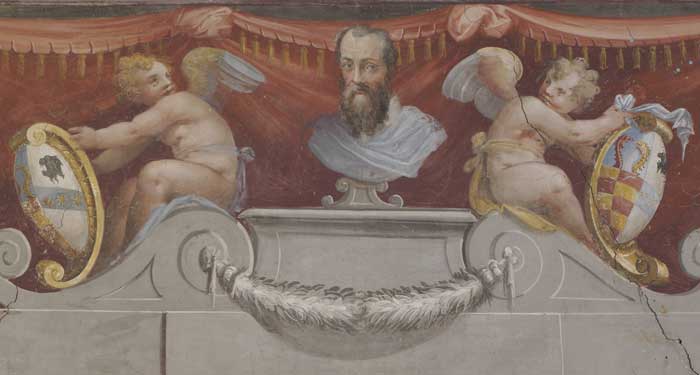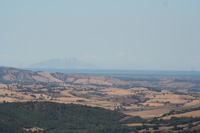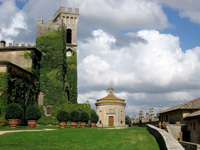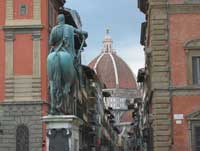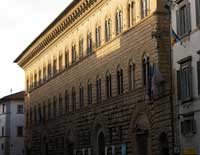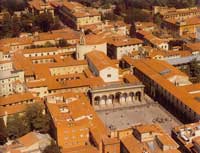| |
|
| The Lives of the Most Excellent Italian Painters, Sculptors, and Architects, from Cimabue to Our Times, or Le Vite de' più eccellenti pittori, scultori, e architettori da Cimabue insino a' tempi nostri, as it was originally known in Italian, is a series of artist biographies written by 16th century Italian painter and architect Giorgio Vasari, which is considered "perhaps the most famous, and even today the most- read work of the older literature of art",[1] "some of the Italian Renaissance's most influential writing on art"[2], and "one of the founding texts in art history".[3] The title is often abridged to the Vite or the Lives.[1]
Background
As the first Italian art historian, Vasari initiated the genre of an encyclopedia of artistic biographies that continues today. Vasari's work was first published in 1550 by Lorenzo Torrentino in Florence,[4] and dedicated to Grand Duke Cosimo I de' Medici. It included a valuable treatise on the technical methods employed in the arts. It was partly rewritten and enlarged in 1568 and provided with woodcut portraits of artists (some conjectural).
The work has a consistent and notorious favour of Florentines and tends to attribute to them all the new developments in Renaissance art—for example, the invention of engraving. Venetian art in particular, let alone other parts of Europe, is systematically ignored.[3][5] Between his first and second editions, Vasari visited Venice and the second edition gave more attention to Venetian art (finally including Titian) without achieving a neutral point of view. John Symonds claimed in 1899 that "It is clear that Vasari often wrote with carelessness, confusing dates and places, and taking no pains to verify the truth of his assertions.", while acknowledging that despite these shortcomings, it is one of the basic sources for information on the Renaissance in Italy.[6]
Vasari's biographies are interspersed with amusing gossip. Many of his anecdotes have the ring of truth, although likely inventions. Others are generic fictions, such as the tale of young Giotto painting a fly on the surface of a painting by Cimabue that the older master repeatedly tried to brush away, a genre tale that echoes anecdotes told of the Greek painter Apelles. He did not research archives for exact dates, as modern art historians do, and naturally his biographies are most dependable for the painters of his own generation and the immediately preceding one. Modern criticism—with all the new materials opened up by research—has corrected many of his traditional dates and attributions.[3] The work is widely considered a classic even today, though it is widely agreed that it must be supplemented by modern critical research.
Vasari includes a 42 page sketch of his own biography at the end of his Vite, and adds further details about himself and his family in his lives of Lazzaro Vasari and Francesco Salviati.[3]
Influence
Vasari's Vite has been described as "by far the most influential single text for the history of Renaissance art"[7] and "the most important work of Renaissance biography of artists".[1] Its influence is situated mainly in three domains: as an example for contemporary and later biographers and art historians, as a defining factor in the view on the Renaissance and the role of Florence and Rome in it, and as a major source of information on the lives and works of early Italian artists.
The Vite have been translated wholly or partially into many languages, including English, Dutch, German, Spanish and French. Early translations became a model for others
The Vite formed a model for encyclopedias of artist biographies. Different 17th century translators became artist biographers in their own country of origin and were often called the Vasari of their country. Karel Van Mander was probably the first Vasarian author with his Painting book (Het Schilderboeck, 1604), which encompassed not only the first Dutch translation of Vasari, but also the first Dutch translation of Ovid and was accompanied by a list of Italian painters who appeared on the scene after Vasari, and the first comprehensive list of biographies of painters from the Low Countries.[1] Similarly, Joachim von Sandrart, author of Deutsche Akademie (1675), became known as the "German Vasari".[8] In England, Aglionby's Painting Illustrated from 1685 was largely based on Vasari as well.[1]
View of the Renaissance
The Vite is also important as the basis for discussions on the development of style,[9] It influenced the view art historians had of the Early Renaissance for a long time, placing too much emphasis on the achievements of Florentian and Roman artists while ignoring those of the rest of Italy and certainly the artists from the rest of Europe.[10]
Source of information
Finally, it has also been for centuries the most important source of information on Early Renaissance Italian (and especially Tuscan) painters and the attribution of their paintings. In 1899, an author like John Addington Symonds used the Vite as one of his basic sources for the description of artists in his 7 books on Renaissance in Italy.[11], and nowadays it is still, despite its obvious biases and shortcomings, the basis for the biography of many artists like Leonardo da Vinci.[12]
Contents
The Vite contains the biographies of many important Italian artists, and is also adopted as a sort of classical reference guide for their names, which are sometimes used in different ways. The following list respects the order of the book, as divided into its three parts. The book starts with a dedication to Cosimo I de' Medici and a preface, and then starts with technical and background texts about architecture, sculpture, and painting. A second preface follows, introducing the actual "Vite" in parts 2 to 5. What follows is the complete list from the second (1568) edition. In a few cases, different very short biographies were given in one section.
|
|
|
|
| |
|

[1] Max Marmor, Kunstliteratur, translated by Ernst Gombrich, in Art Documentation Vol 11 # 1, 1992
[2] University of Leeds website
[3] Victor Ginsburgh and Sheila Weyers, Persistence and Fashion in Art, Louvain (2005)
[4] Christopher Witcombe, Art History and Technology
[5] Takuma Ito, Studies of Western Art #12, July 2007
[6] John Symonds' "Renaissance in Italy" Vol 3 part 2
[7 ]Professor Hope, The Warburg Institute, course synopsis, 2007
[8] Abstract from the transactions of the bibliographical society
[9] Elinor Richter, reviewing Philip Sohms study of style in the art theory :"Giorgio Vasari's Vite, the first edition of which was published in 1550, provides the foundation for any discussion of the development of style."
[10] Stephanie Leone, The Renaissance Society of Americ, 2007: "[...] the traditional definition of Renaissance art as the humanistic innovations of Florentine and Roman artists, to which Giorgio Vasari's Vite (1550, 1568) gave rise."
[11] Full text of John Symonds' "Renaissance in Italy"
[12] Bernard Barryte, The life of Leonardo da Vinci, University of Rochester Library Bulletin (1984) |
|
|

Giorgio Vasari | Lives of the Most Eminent Painters Sculptors and Architects
This is a 10-volume translation of Vasari's biographies of Italian artists, issued in London by Macmillan and the Medici Society between 1912 and 1915.
The Internet Archive has various page image formats for all 10 volumes, and Project Gutenberg has illustrated transcriptions.
Volume I | Cimabue to Agnolo Gaddi
Translator's preface to this edition; Dedications to Cosimo de' Medici (1550 and 1568); Imprimatur of Pope Pius V; The author's preface to the whole work; The author's preface to the lives; Giovanni Cimabue; Arnolfo di Lapo; Niccola and Giovanni of Pisa (Niccola Pisano; Giovanni Pisano); Andrea Tafi; Gaddo Gaddi; Margaritone; Giotto; Agostino and Agnolo of Siena; Stefano and Ugolino Sanese (Ugolino da Siena); Pietro Laurati (Pietro Lorenzetti); Andrea Pisano; Buonamico Buffalmacco; Ambrogio Lorenzetti; Pietro Cavallini; Simone Sanese (Simone Memmi or Martini); Taddeo Gaddi; Andrea di Cione Orcagna; Tommaso, called Giottino; Giovanni dal Ponte; Agnolo Gaddi; Index of names
Volume II | Berna to Michelozzo Michelozzi
Berna; Duccio; Antonio Viniziano; Jacopo Di Casentino; Spinello Aretino; Gherardo Starnina; Lippo; Don Lorenzo Monaco; Taddeo Bartoli; Lorenzo Di Bicci; The author's preface to the second part; Jacopo della Quercia (Jacopo della Fonte); Niccolo Aretino (Niccolo d'Arezzo or Niccolò di Piero Lamberti); Dello; Nanni D'antonio Di Banco; Luca Della Robbia; Paolo Uccello; Lorenzo Ghiberti (Lorenzo di Cione Ghiberti or Lorenzo di Bartoluccio Ghiberti); Masolino Da Panicale; Parri Spinelli; Masaccio; Filippo Brunelleschi (Filippo di Ser Brunellesco); Donato (Donatello); Michelozzo Michelozzi; Index of names
Volume III | Filarete And Simone To Mantegna
Antonio Filarete and Simone; Giuliano da Maiano; Piero della Francesca (Piero Borghese); Fra Giovanni da Fiesole (Fra Angelico); Leon Batista Alberti; Lazzaro Vasari; Antonello da Messina; Alesso Baldovinetti; Vellano da Padova; Fra Filippo Lippi; Paolo Romano, Maestro Mino (Mino del Regno or Mino del Reame), and Chimenti Camicia; Andrea dal Castagno of Mugello (Andrea degl' Impiccati) and Domenico Viniziano (Domenico da Venezia); Gentile da Fabriano and Vittore Pisanello of Verona; Pesello and Francesco Peselli (Pesellino or Francesco di Pesello); Benozzo Gozzoli; Francesco di Giorgio and Lorenzo Vecchietto; Galasso Ferrarese (Galasso Galassi); Antonio Rossellino (Rossellino dal Proconsolo) and Bernardo his Brother; Desiderio da Settignano; Mino da Fiesole (Mino di Giovanni); Lorenzo Costa; Ercole Ferrarese (Ercole da Ferrara); Jacopo, Giovanni, and Gentile Bellini; Cosimo Rosselli; Cecca; Don Bartolommeo della Gatta, Abbot of S. Clemente; Gherardo; Domenico Ghirlandajo; Antonio and Piero Pollaiuolo; Sandro Botticelli (Alessandro Filipepi or Sandro di Botticello); Benedetto da Maiano; Andrea Verrocchio; Andrea Mantegna; Index of names
Volume IV | Filippino Lippi To Domenico Puligo
Filippo Lippi, called Filippino; Bernardino Pinturicchio; Francesco Francia; Pietro Perugino (Pietro Vannucci, or Pietro da Castel della Pieve); Vittore Scarpaccia (Carpaccio), and other Venetian and Lombard Painters; Jacopo, called L'Indaco; Luca Signorelli (Luca da Cortona); The author's preface to the third part; Leonardo da Vinci; Giorgione da Castelfranco; Antonio da Correggio; Piero di Cosimo; Bramante da Urbino; Fra Bartolommeo di San Marco (Baccio della Porta); Mariotto Albertinelli; Raffaellino del Garbo; Torrigiano; Giuliano and Antonio da San Gallo; Raffaello da Urbino (Raffaello Sanzio); Guglielmo da Marcilla (Guillaume de Marcillac); Simone, called Il Cronaca (Simone del Pollaiuolo); Domenico Puligo; Index of names
Volume V | Andrea Da Fiesole to Lorenzo Lotto
Andrea da Fiesole (Andrea Ferrucci), and Others; Vincenzio da San Gimignano (Vincenzio Tamagni), and Timoteo da Urbino (Timoteo della Vite); Andrea dal Monte Sansovino (Andrea Contucci); Benedetto da Rovezzano; Baccio da Montelupo, and Raffaello his son; Lorenzo di Credi; Lorenzetto and Boccaccino; Baldassarre Peruzzi; Giovan Francesco Penni (called Il Fattore), and Pellegrino da Modena; Andrea del Sarto; Madonna Properzia de' Rossi; Alfonso Lombardi, Michelagnolo da Siena, Girolamo Santa Croce, and Dosso and Battista Dossi; Giovanni Antonio Licinio of Pordenone, and Others; Giovanni Antonio Sogliani; Girolamo da Treviso; Polidoro da Caravaggio and Maturino; Il Rosso; Bartolommeo da Bagnacavallo, and Others; Franciabigio (Francia); Morto da Feltro and Andrea di Cosimo Feltrini; Marco Calavrese; Francesco Mazzuoli (Parmigiano); Jacopo Palma (Palma Vecchio) and Lorenzo Lotto; Index of names
Volume VI | Fra Giocondo To Niccolò Soggi
Fra Giocondo, Liberale, and Others; Francesco Granacci (Il Granaccio); Baccio d' Agnolo; Valerio Vicentino (Valerio Belli), Giovanni da Castel Bolognese (Giovanni Bernardi), Matteo dal Nassaro, and Others; Marc' Antonio Bolognese, and Others; Antonio da San Gallo; Giulio Romano; Fra Sebastiano Viniziano del Piombo; Perino del Vaga; Giorgio Vasari, to the Craftsmen in Design; Domenico Beccafumi; Giovanni Antonio Lappoli; Niccolo Soggi; Index of names
Volume VII | Tribolo to Il Sodoma
Niccolo, called Tribolo; Pierino (Piero) da Vinci; Baccio Bandinelli; Giuliano Bugiardini; Cristofano Gherardi, called Doceno; Jacopo da Pontormo; Simone Mosca; Girolamo and Bartolommeo Genga, and Giovan Battista San Marino; Michele San Michele; Giovanni Antonio Bazzi, called Il Sodoma; Index of names
Volume VIII | Bastiano to Taddeo Zucchero
Bastiano Da San Gallo, called Aristotile; Benvenuto Garofalo and Girolamo da Carpi, and Other Lombards; Ridolfo, David, and Benedetto Ghirlandajo; Giovanni da Udine; Battista Franco; Giovan Francesco Rustici; Fra Giovanni Agnolo Montorsoli; Francesco Salviati; Daniello Ricciarelli; Taddeo Zucchero; Index of names
Volume IX | Michelagnolo To The Flemings
Michelagnolo Buonarroti; Francesco Primaticcio; Tiziano da Cadore; Jacopo Sansovino; Leone Lioni of Arezzo; Don Giulio Clovio; Divers Italian Craftsmen still living; Divers Flemings; Index of names
Volume X | Bronzino to Vasari, & General Index
Academicians of Design, Painters, Sculptors, and Architects; Description of the Festive Preparations for the Nuptials of the Prince Don Francesco of Tuscany; Giorgio Vasari; Index of names; General index of all volumes
Bibliography: Le vite de'più eccellenti pittori, scuttori e architetti. Florence: Lorenzo Torrentino, 1550. Enlarged ed., Florence: T. Giunti, 1568.
Lives of the Most Eminent Painters, Sculptures and Architects. Translated by Gaston du C. de Vere. 10 vols. London: Macmillan and the Medici Society, 1912-15; Ragionamenti del Sig. cavaliere Giorgio Vasari, pittore et architetto aretino, sopra le inuentioni da lui dipinte in Firenze nel palazzo di Loro Altezze Serenissime. Florence: F. Giunti, 1588.
|
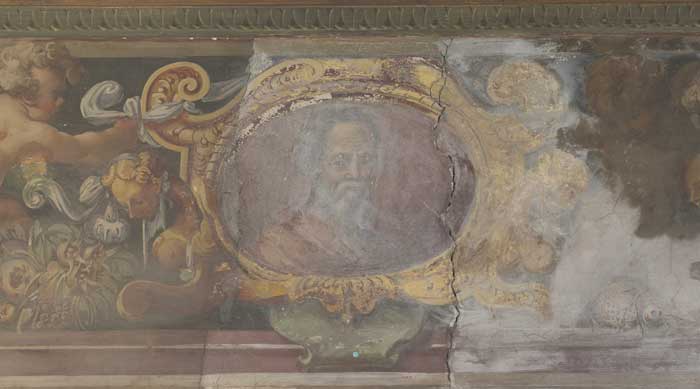 |
Giorgio Vasari, Leonardo da VinciMichelangelo, portrait medallion in the upper frieze in the Sala Grande, south-east wall,
state during cleaning of the paint surface, Casa Vasari, Florence.
From Vasari’s original residence only the frescoes in the Sala Grande (around 1572) have survived, and they are in a precarious state of conservation.
|
Casa di Vasari (Vasari's House) - Arezzo
Casa del Vasari is the artist's home in Arezzo. Vasari himself was responsible for the layout and furnishings (around 1540).
It is situated in Via Venti Settembre, not far from Piazza S.Domenico and is a typical example of Tuscan manieristic style.
It was enlarged in the 19th century and was used as a private residence until the present century, but it now houses the Vasari museum and its archive. In addition to Vasari’s frescos, the house contains a number of works by artists of the second Mannerism and also includes important archives with letters by Michelangelo, Pius V, Cosimo I and Francesco de’ Medici.
Address: Via XX Settembre 55, 52100 Arezzo (AR)
Opening hours: 9:00 am-7:00 pm, closed on Tuesday
|
Casa Vasari in Florence
Giorgio Vasari’s Florentine residence is a stone’s throw from Santa Croce in the street of the same name, Borgo Santa Croce, house number 8. At Vasari’s request, Duke Cosimo I. had initially let the building to him in 1557 before gifting it to him four years later in recognition of his artistic achievements. With the help of his studio, Vasari frescoed the walls of the Sala Grande on the first floor around 1572 with ancient artistic legends, allegorical representations and a series of portraits of important painters, sculptors and architects of the Renaissance. The programme, which could be attributed to Vasari’s friend, the humanist Vincenzo Borghini, is dedicated to the portrayal of Vasari as an artist, humanist and scholar. In its entirety, it represents the complete achievements of his theoretical and practical experiences gathered during his lifetime. Parts of the fresco programme can be traced to the earlier frescoes Vasari created between 1542 and 1548 for his residence in Arezzo. After his death in 1574, the house in Florence remained in the hands of Vasari’s family, and then was passed to an Aretine lay brotherhood in 1687, until finally purchased by the Morrocchi family in the 19th century, who still owns it today. Only the Sala Grande remained untouched by the numerous reconstructions that the Palazzo was subjected to over the course of time.
On the left of the majestic chimney on the northwest wall of the Sala Grande a kneeling youth is portrayed. He is tracing the contours of his shadow on the wall by the light of a lamp. Vasari himself provides the key to interpreting this scene in the preface to the “Lives”, in which a long passage is devoted to the question of the origins of art: With reference to the ancient author Pliny the Elder and his “Naturalis historiae", Vasari tells the story of Gyges of Lydia, who sat by the fire contemplating his own shadow and then followed his instinct to sketch it on the wall with a piece of charcoal. In stylizing Gyges as the first artist in his interpretation of the Pliny text, Vasari thus perceives the beginning of art as a narcissistically motivated making of a self-portrait. However, Vasari considered Gyges’ drawing not only the starting point of painting, but also the common foundation for all arts. This ambitious concept of the “disegno” (drawing, draft), which runs through Vasari’s entire theoretical writing, was also practiced in the “Accademia del Disegno” in Florence, established in 1563. Vasari was one of the founding members of this institution, which is considered to be one of the first art schools in Europe.
In the centre of the wall opposite to the chimney is the story of the Greek painter Zeuxis of Heraclea and the beautiful maidens, which was told by Pliny in chapter 35 of his “Naturalis historiae”: Zeuxis was commissioned by the residents of Agrigento to create a female portrait for their temple honouring Juno. As a result, the painter chose five of the most beautiful girls in the city, who were to model for him together, so that he could merge the most beautiful feature of each one into a single perfect portrait. This story, which is intended to illustrate the superiority of art over nature, deals with the much discussed question since ancient times of the relationship between art and nature. In nature, Vasari saw the teacher of art, which should not simply imitate nature, but try to surpass it. In the fresco, he selected this concept as a central theme using the comparison of two sequences from the tale: On the right side, the maidens are being led to the artist’s studio. Their route takes them past the many-breasted herm of Diana of Ephesus, who was honoured in the ancient world as the goddess of nature. On the left side, Zeuxis stands before the easel in his studio and merges the examples from nature into a perfect artistic creation. The “disegno”, which means in Vasari’s own words “the imitation of the most beautiful elements of nature”, acts as a mediator between the two concepts depicted in the scenes. It is represented by a figure of the statue of a naked youth
Pliny again provided the basis for the portrayal of Apelles and the cobbler on the south-east wall. According to Pliny’s tale, the Greek painter Apelles liked to present his works to the general public after their completion, to hear their opinion, because he was of the opinion that the verdict of nonexpert viewers could include many important points. At such times, he hid himself, so that his presence did not influence anyone. One day, a cobbler came and criticised the representation of a sandal in a picture. Apelles, who felt that the criticism was justified, revised his painting as a consequence. The cobbler came again the next day. Pleased that the painter had taken his objection seriously, he proceeded to criticise the painting technique used for a leg. This enraged Apelles, who came out of his hiding place and punished the cobbler with the words that remain a proverb until today: “Ne sutor ultra crepidam” (Cobbler, do not judge higher than the sandals). The power of judgment (“giudizio”), schooled with intellectual and practical experience, to which this story alludes, occupies an important role in Vasari’s theory of art. The artist can use it as a self-test, with the help of which he can avoid excessively unrestrained ideas. However, the issue of individual taste also plays a role in this case; according to Vasari, only true connoisseurs of art will reach a common verdict due to their application of the same criteria in their analysis.
One of the central artistic debates of the 16th century concerned the question of the “paragone” (the comparison of artistic media). In particular, the discussion questioned which of the three fine arts (painting, sculpture or architecture) takes precedence over the other two. While other artists declared a clear preference for one or the other category, Vasari expressed more reserve and emphasised more their common characteristics. His perspective was that they were all based on the “disegno” (drawing, draft), which decided the quality of the work. The portrayal of the youth drawing his shadow beside the chimney has already been interpreted in this spirit, but also the portrayal of the allegories of the arts, which frame the main scenes on the walls of the Sala Grande, should be understood in this context. In addition to the allegories of painting, sculpture and architecture, two further allegories have been added: Those of poetry and of music. For Vasari, the poet extracted his material from nature, similar to the way the artist did, to then “continue to draw” it with the help of inspiration. In contrast, the allegory of music is a 19th century addition, that was added after one of the doors of the Sala was shut.
In the second edition of “Lives”, which was published in Florence in 1568, Vasari had not only extensively revised and added to the book, but also preceded the individual lives with a woodcut showing a portrait of the respective artist. These representations were used as templates for the portrait medallions in the upper frieze in the Sala Grande, for which Vasari selected from the total of 159 lives thirteen artists who he held in particularly high admiration: Cimabue und Giotto as forerunners, Brunelleschi, Donatello, and Masaccio as the founders of Renaissance art, followed by Leonardo da Vinci, Raphael, and finally Michelangelo, who Vasari admired throughout his life. Further portraits here are of Raphael’s followers Perin del Vaga and Giulio Romano; Andrea del Sarto, one of his teachers, and Rosso Fiorentino, whose art was a powerful influence on Vasari’s early works; and finally, Francesco Salviati, who had worked together with Vasari in Rome. With this sequence of pictures, which can be assigned to the tradition of the “uomini illustri”, Vasari succeeded in creating an impressive illustration of the newly earned self-assurance of the artist in the 16th century.'
See also: Exhibition of the Photo Library of the Kunsthistorisches Institut in Florenz (Max-Planck-Institut
The online exhibition presented here is dedicated to the Casa Vasari in Florence. It was the residence of the painter of Duke Cosimo I of Tuscany, but was previously little-known among the public for various reasons and was also relatively neglected by the academic world until now. From Vasari’s original residence, which is not easily accessible even today, only the frescoes in the Sala Grande (around 1572) have survived, and they are in a precarious state of conservation.
Giorgio Vasari’s Florentine residence is a stone’s throw from Santa Croce in the street of the same name, Borgo Santa Croce, house number 8.
|
|
This article incorporates material from the Wikipedia articles Le Vite, Accademia delle Arti del Disegno and Giorgio Vasari published under the GNU Free Documentation License.
Wikimedia Commons has media related to Le Vite and Giorgio Vasari.
This article incorporates text from a publication now in the public domain: Chisholm, Hugh, ed (1911). Encyclopædia Britannica (Eleventh ed.). Cambridge University Press.
The Lives of the Artists (Oxford World's Classics). Oxford University Press, 1998. ISBN 0-19-283410-X
Lives of the Painters, Sculptors and Architects, Volumes I and II. Everyman's Library, 1996. ISBN 0-679-45101-3
|
| |
|
|

Tuscany is one of the most popular tourist destinations in the world. Known for its enchanting landscapes, its fantastic and genuine food and beautiful towns as Florence, Pisa, Lucca and Siena. Tuscany is much more! Spas and thermal baths, natural parks and caves, traditional festivals & tastings. Podere Santa Pia is located in the heart of the Valle d'Ombrone, and one can easily reach some of the most beautiful attractions of Tuscany, such as Montalcino, Pienza, Montepulciano and San Quirico d'Orcia, famous for their artistic heritage, wine, olive oil production and gastronomic traditions. It is the ideal place to pass a very relaxing holiday in contemplation of nature, with the advantage of tasting the most typical dishes of Tuscan cuisine and its best wines.
This is the land where the DOC wines Montecucco and Brunello are produced. So, the surrounding countryside is the ideal area for an uncommon wine tour, visiting small farms producing wine and excellent extra virgin olive oil.
Not far from Cinigiano and clearly visible from Podere Santa Pia, is the famous Castle of Poggio alle Mura, also known as Villa Banfi and home to one of the most popular producers of Brunello di Montalcino D.O.C.G. wine. Set in 7100 hectares of land in the Montalcino area, Castello Banfi il Borgo is one of the most important wine producers in Tuscany.
If you want to spend an unforgettable holiday at Podere Santa Pia and visit these beautiful medieval castles and wineries, visit our special offers page or contact us.
|
| |
|
|
|
|
|
|
|
Podere Santa Pia |
|
Podere Santa Pia, garden |
|
The Maremma and Isola Grigio |
| |
|
|
|
|
|
|
|
|
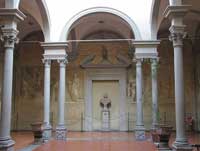
|
Villa Celsa near Florence |
|
Piazza della Santissima Annunziata
in Florence |
|
Choistro dello Scalzo, Florence |
| |
|
|
|
|
|
|
|
|
|
Palazzo Medici Riccardi, Florence |
|
Piazza della Santissima Annunziata
in Florence |
|
Florence, Duomo |
| |
|
|
|
|
Accademia delle Arti del Disegno
The Accademia delle Arti del Disegno ("Academy of the Arts of Drawing") of Florence promotes the safeguard of the works of art in Italy. Founded in 1563, it was the first academy of drawing established in Europe.
Founded by Cosimo I de' Medici, on 13 January 1563, under the influence of the architect Giorgio Vasari, it had been initially denominated Accademia e Compagnia delle Arti del Disegno—Academy and Company for the Arts of Drawing—as it was divided into two different operative branches.
While the Company was a kind of corporation which every working artist in Tuscan should join, the Academy was constituted only by the most eminent artistic personalities of Cosimo’s court, and had the task of supervising the whole artistic production of the medicean state.
The extraordinary contribution of academics as Michelangelo Buonarroti, Francesco da Sangallo, Agnolo Bronzino, Benvenuto Cellini, Giorgio Vasari, Bartolomeo Ammannati, Giambologna, Tiziano, Tintoretto, Palladio etc. increased the prestige of this institution, certainly not reduced to the politic and economic limits of the medicean principality. The first woman honoured with the admission in the academy was Artemisia Gentileschi.
The granduca Pietro Leopoldo di Lorena, in 1784, subtracted all kind of professional artistic responsibility from the Company, conferring this task to the just founded Accademia di Belle Arti. The Academics College of the prestigious medicean institution conserved the task of artistic formation and supervision of artistic production of the Granducato di Toscana.
The headquarters of the academy nowadays is Palazzo dell'Arte dei Beccai. The institution is divided in six classes: Painting Class, sculpture class, Architecture Class, History of Art Class, humanistic Disciplines and Sciences Class. The Academics are divided in Emerita, Ordinaries and Correspondents.
Among the Academics internationally famous are:
for the Painting Class: Leonardo Cremonini, Hans Erni, Lucian Freud, Richard Hamilton, Anselm Kiefer, Piero Guccione.
for the Sculpture Class: Arnaldo Pomodoro, Giuliano Vangi, Dani Karavan.
for the Architecture Class: Massimo Carmassi, Marco Dezzi Bardeschi, Adolfo Natalini, Paolo Portoghesi, Aldo Loris Rossi, David Palterer, Franco Purini.
For the History of Art Class: Wolfram Prinz, Erich Steingräber, Detlef Heikamp, Antonio Paolucci, Zygmunt Wazbinski, David Whitehouse.
For the Humanistic disciplines and Science Class: Francesco Adorno, Franco Cardini, Umberto Colombo, Tullio Gregory, Salvatore Accardo, Carlo Ginzburg.
Moreover an unperiodically awarded title, that of Accademico d'Onore, is given by the Accademia for contributions to society and as a certificate of excellence in the political, scientific and cultural fields. Among the awarded are notable: Jasper Johns, Alberto Ronchey, Giulio Andreotti, Louis A. Waldman, the Nobel Prize Rita Levi-Montalcini and the Pritzker Prizes Philip Johnson, Jørn Utzon, Robert Venturi and Renzo Piano.
The President is Prof. Arch. Luigi Zangheri.
Official site of the Accademia | www.aadfi.it
|
|
|
